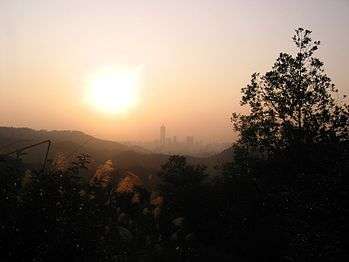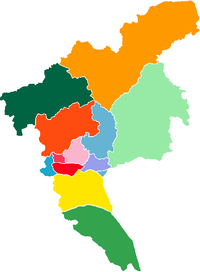Baiyun Mountain (Guangdong)
| Baiyun Mountain | |
|---|---|
 Baiyun with Zhujiang New Town in the distance | |
| Highest point | |
| Elevation | 427 m (1,401 ft) |
| Geography | |
| Location | Guangzhou, Guangdong, China |
| Baiyun Mountain | |||||||||||||
|
Entrance to the Baiyun Scenic Area | |||||||||||||
| Simplified Chinese | 白云山 | ||||||||||||
|---|---|---|---|---|---|---|---|---|---|---|---|---|---|
| Traditional Chinese | 白雲山 | ||||||||||||
| Cantonese Yale | Baahkwàhn Sāan | ||||||||||||
| Cantonese Jyutping | Baak6-wan4 Saan1 | ||||||||||||
| Hanyu Pinyin | Báiyúnshān | ||||||||||||
| Postal | Pakwan Mountain | ||||||||||||
| Literal meaning | White Cloud Mountain | ||||||||||||
| |||||||||||||
| Alternative Chinese name | |||||||||||||
| Simplified Chinese | 云山 | ||||||||||||
| Traditional Chinese | 雲山 | ||||||||||||
| Cantonese Yale | Wàhnsāan | ||||||||||||
| Cantonese Jyutping | Wan4-saan1 | ||||||||||||
| Hanyu Pinyin | Yúnshān | ||||||||||||
| Literal meaning | Cloudy Mountain | ||||||||||||
| |||||||||||||
Baiyun Mountain, also known as White Cloud Mountain, is a mountain located a few miles to the north of Guangzhou, China, and which is at a height of 427m.[1]
Name
Báiyún is Mandarin Chinese for "White Clouds", derived from views of the mountain's peaks shrouded in mist during late Spring or after a rain.[2] Its former English name, Pakwan, is a form of the Cantonese pronunciation of the same name. In English, it is also known as White Cloud Mountain, Mount Baiyun, Baiyun Shan, or—since the "mountain" is, properly speaking, a "mountain range"—the "Baiyun Mountains".
Baiyun is informally known as the "City's Lung" (市肺), from its greenery. It is also acclaimed as the "First Beauty in Guangzhou” (羊城第一秀)[2] or the “Most Famous Mountain South of Ling” (岭南第一名山).[3] Moxing Peak, its highest point, is similarly sometimes called the “First Peak under the Southern Sky” (天南第一峰).[2]
History
| Scenes on Baiyun Mountain named in Eight Sights of Guangzhou | ||
|---|---|---|
| Time | Chinese | English |
| Song Dynasty | 蒲涧帘泉 | Lianquan Fountain at Cattail Gully |
| Yuan Dynasty | 蒲间濂泉 | |
| 白云晚望 | Evening Vista from Baiyun | |
| 景泰僧归 | Jingtai's Returning Monks | |
| 1963 | 白云松涛 | Baiyun's Pine Sea |
| 1986 | 云山锦绣 | Cloudy Mountain's Grandeur |
| 2002 | 云山叠翠 | Cloudy Mountain's Lush Greenery |
| 2011 | 云山叠翠 | Cloudy Mountain, Green and Tidy |
Baiyun Mountain has been famed as a scenic spot since ancient times.[2] Its visitors predated the foundation of Panyu (now Guangzhou) in 214 BC, with various celebrities of the Warring States period (5th–3rd centuries BC) known to have traveled there. Its beauty was again celebrated during the 3rd–5th century Jin Dynasty and the 7th–9th century Tang.[4] Since the Song, various scenes at Baiyun have been named among the Eight Sights of Ram City, lists of Guangzhou's loveliest spots.[4][5][3] However, few of the historical sites have survived to the present day[2] and others—such as the view of Guangzhou's old walled city at dusk—have changed drastically as the city has expanded to and around the mountain.
Gallery
- Suoai Tai
 The entrance to Moxing Peak
The entrance to Moxing Peak- China Mobile's telecom tower
Wildlife
The White Cloud Mountain minnow, now a popular aquarium fish worldwide, was discovered in this area in the 1930s.[6]
References
- ↑ "White Cloud Mountain (Baiyun Shan)". Guangzhou. Michelin. Retrieved 21 August 2018.
- 1 2 3 4 5 "白云山简介 [Brief Introduction to Baiyun Mountain]", Baiyuan Scenic Area, retrieved 7 July 2010 . (in Chinese)
- 1 2 "新世纪羊城八景 [Ram City's Eight Sights in the New Century", Official site, Guangzhou Municipal People's Government, 10 June 2005, retrieved 7 July 2010 . (in Chinese)
- 1 2 "白云山风景名胜区 [Baiyun Mountain Scenic Area]", Guangzhou News, 1 September 2008, retrieved 7 July 2010 . (in Chinese) & (in English)
- ↑ "历史上的羊城八景 [Ram City's Eight Sights in History]", Guangzhou Culture Bureau, retrieved 7 July 2010 . (in Chinese)
- ↑ "Rediscovering the Wild Population of White Cloud Mountain Minnows (Tanichthys albonubes)", Europe PMC, retrieved 12 March 2016 .
External links
Coordinates: 23°11′12″N 113°17′41″E / 23.186642°N 113.294749°E

